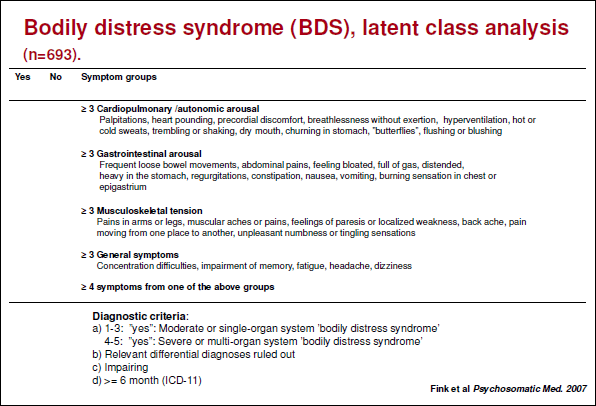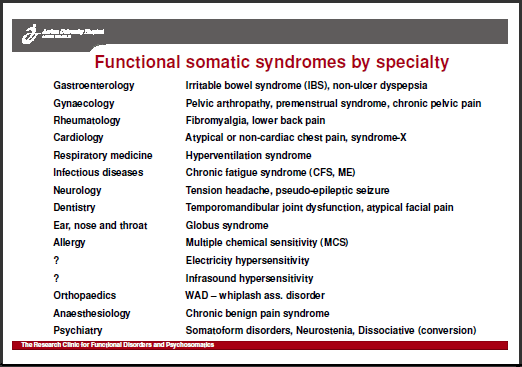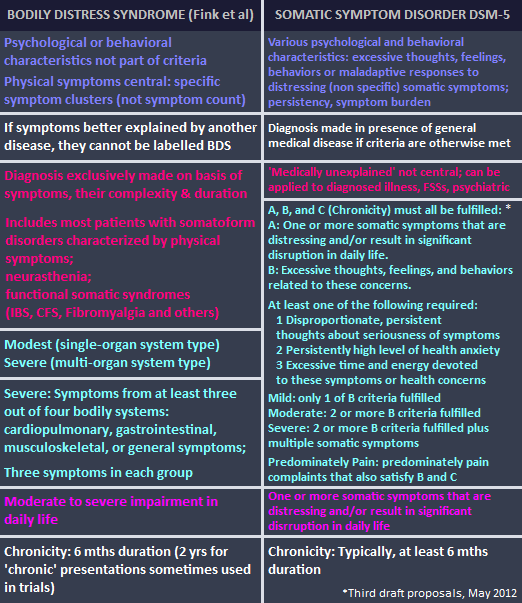ICD-11 Beta draft and Bodily Distress Disorders; Per Fink and Bodily Distress Syndrome: Parts One and Two
February 3, 2013
Part Two: Bodily Distress Syndrome (BDS)
According to the authors of this June 2012 EACLPP Conference Abstract: Bodily Distress Syndrome: A new diagnosis for functional disorders in primary care, the concept of Bodily Distress Syndrome
“is expected to be integrated into the upcoming versions of classification systems.”
In May 2010, Professor Per Fink and Andreas Schröder, PhD, MD, Aarhus Universitetshospital, Denmark, published the paper, “One single diagnosis, bodily distress syndrome, succeeded to capture 10 diagnostic categories of functional somatic syndromes and somatoform disorders.” [Abstract: PMID: 20403500] [3].
The full text of this paper is behind a paywall, so I provide other sources of information on the BDS construct, which is already in use in Denmark, in both research trials and clinical settings.
According to the Per Fink (Stress-4) Clinical Trial for BDS:
“…BDS is a unifying diagnosis that encompasses a group of closely related conditions such as somatization disorder, fibromyalgia, irritable bowel syndrome and chronic fatigue syndrome.” [4]
According to PhD Thesis: Fjorback, LO. “Mindfulness and Bodily Distress.”:
“…The present thesis uses the term BDS because it is developed from empirical research, and it covers the most important functional somatic syndromes [5,6]. Thus, BDS is a classification that may unite functional somatic syndromes and somatization disorder. The BDS concept is based on specific symptom clusters, and it includes most patients with somatoform disorders, despite psychological symptoms or behavioral characteristics not being part of the diagnostic criteria [7]…In this study, we included the multi-organ type BDS that requires functional somatic symptoms from at least three out of four bodily systems: the cardiopulmonary, gastrointestinal, musculoskeletal, or general symptoms, and moderate to severe impairment in daily living, and at least six months of duration (Table 1). [5]
Criteria for BDS are set out, here, in Slide Presentation One
Somatoform disorders – functional somatic syndromes – Bodily distress syndrome.
Need for care and organisation of care in an international perspective – EACLPP Lecture
The Research Clinic for Functional Disorders and Psychosomatics
Prof. Per Fink MD, Ph.D, Dr.Med.Sc. (EACLPP lecture, June 2012) [PDF, in English] Reference [6].
Slide #6 of 23

The Danish Research Clinic for Functional Disorders and Psychosomatics is headed by Professor Per Fink.
Information written for patients in this document: [PDF, in English] [7]
“…Various medical specialties use their own diagnoses for patients with functional disorders. Some patients with BDS receive the below-mentioned diagnoses, which can give rise to confusion. You may have received one or more of the following diagnoses:
• Fibromyalgia
• Chonic fatigue syndrome (CFS)
• Irritable bowel syndrome (IBS)
• Chronic pain disorder
• Somatisation disorder
• Multiple chemical sensitivity (MCS)
• Whiplash associated disorder (WAD)”
[Ed: On other BDS presentation slides, I have also seen “Stress and burn out…and many more…” added to the list above.]
“However, recent research suggests that the different diagnoses are all subcategories of one single illness, namely BDS.
“…BDS is a new research diagnosis and therefore unfamiliar to many doctors. Most doctors do know the different diagnoses mentioned in the above box, but they are unaware that they can be viewed as one single illness…”
The Research Clinic for Functional Disorders and Psychosomatics website states:
“Bodily Distress Syndrome (abbreviated ‘BDS’) is a new diagnosis which until now primarily has been used in connection with scientific work…
“How is BDS diagnosed?
“Through examinations, interviews and the medical history, we can assess whether a patient meets the criteria for suffering from BDS. The GP assesses the complexity of the symptoms and whether the symptoms could be caused by a specific disease, e.g. whether joint pain can be explained by arthritis or whether a shortness of breath could be caused by asthma.
“If the symptoms are better explained by another disease, they cannot be labelled BDS. The diagnosis is therefore exclusively made on the basis of the symptoms, their complexity and duration. Currently, no single examination exists, e.g. a blood test or a scan, which can tell us whether someone suffers from BDS.
“…BDS is divided into a ‘single-organ’ type and a ‘multi-organ’ type. The difference between the two lies in the number of bodily systems that are affected by the disorder. All symptoms do not need to be present at the same time. Additionally, the patients must be so impeded by their symptoms that these affect their way of living.”
[…]
“Other names for BDS
“We find patients with functional disorders in all of our hospital wards. Medical specialists have developed various diagnoses for patients with functional disorders. Therefore, some BDS patients experience that they get different diagnoses, which can be very confusing….
“BDS: one diagnosis
“Recent research indicates that the various diagnoses are subtypes of the same disorder. Studies have shown that patients often experience the same symptoms in spite of the different diagnoses. For example, a patient with fibromyalgia may also have stomach problems and suffers from fatigue. A patient with Chronic Fatigue Syndrome may likewise experience muscle pain and rapid heartbeat. The many different diagnoses indicate that BDS is multi-factorial, as described in the above…” [8]
Slide #4 of 23: Functional somatic syndromes by specialityReference [6]

This June 2010 Danish journal article sets out proposals for a new classification:
Journal article: Ny fælles diagnose for de funktionelle sygdomme. Fink P, Rosendal, M et al [PDF, in Danish] Reference [9]
[Ed: Note: This proposal has three hitherto discrete ICD-10 classifications, FM (M79.7), IBS (K58) and CFS (indexed to G93.3 in ICD-10; classified in ICD-11 Beta draft as an ICD Title term in Chapter 6: Diseases of the nervous system) proposed to be relocated under a new classification, ‘Bodily Distress Syndrome,’ along with Neurasthenia (F48.0), and some ICD-10 and DSM-IV Somatoform Disorders.]
Page 1837
Proposed new classification on left; Current classification on right:

Here, the same proposal set out in English, from a Danish presentation:
(Note: MS type = Musculoskeletal)
Slide Presentation Two [PDF, in Danish; some slides in English] Reference [10]
Bodily Distress Syndrome (BDS), og helbredsangst Udvikling af diagnoserne, assessment og forskning på området, Oplæg ved Sundhedspsykologisk, Årsmøde 2011
Slide #11 of 97

Comparisons
At the time of writing, there is insufficient information displaying in the public version of the ICD-11 Beta drafting platform to compare proposals and criteria for ICD-11’s Bodily Distress Disorder with Per Fink et al’s Bodily Distress Syndrome. I shall be reporting on proposals as they emerge.
The graphic below compares mutli-organ Bodily Distress Syndrome with DSM-5’s Somatic Symptom Disorder, as the DSM-5 third draft criteria had stood at May 2012.
Depending on screen size/resolution, graphic may not display in full. Click on the image and the image file will load.

Graphic: Suzy Chapman
References:
1 Update on ICD-11 Beta draft: Bodily Distress Disorder (proposed for ICD-11 Chapter 5: Mental and behavioural disorders), Dx Revision Watch, January 6, 2013: http://wp.me/pKrrB-2Bg
An earlier, more comprehensive report can be found here: Changes to ICD-11 Beta drafting platform: Bodily Distress Disorders (1), Dx Revision Watch, July 2, 2012
2 Goldberg DP. Comparison Between ICD and DSM Diagnostic Systems for Mental Disorders. In: Sorel E, (Ed.) 21st Century Global Mental Health. Jones & Bartlett Learning, 2012: 37-53 [Free PDF, Sample Chapter Two]
http://samples.jbpub.com/9781449627874/Chapter2.pdf
3 Fink P, Schröder A. One single diagnosis, bodily distress syndrome, succeeded to capture 10 diagnostic categories of functional somatic syndromes and somatoform disorders. J Psychosom Res. 2010 May;68(5):415-26. [Abstract: PMID: 20403500].
4 Acceptance and Commitment Therapy for Patients With Multi-organ Bodily Distress Syndrome (Stress-4)
http://clinicaltrials.gov/ct2/show/NCT01518647
5 PhD Thesis: Fjorback, LO. Mindfulness and Bodily Distress. Danish Medical Journal [PDF, in English]
http://www.danmedj.dk/portal/pls/portal/!PORTAL.wwpob_page.show?_docname=9351003.pdf
6 Slide presentation: Per Fink: Somatoform disorders – functional somatic syndromes – Bodily distress syndrome (EACLPP lecture, June 2012), Research Clinic for Functional Disorders and Psychosomatics [PDF, in English]
http://www.eaclpp.org/tl_files/content/Presentations/EACLPP_Per%20Fink_Somatoform%20Disorders.pdf
7 Patient information manual on BDS, Aarhus, Denmark [PDF, in English]
8 Research Clinic for Functional Disorders and Psychosomatics webpages for BDS:
http://funktionellelidelser.dk/en/about/bds/
9 Journal article: Fink P, Rosendal M, et al. Ny fælles diagnose for de funktionelle sygdomme. Ugeskr Læger 172/24, 14. juni 2010. pp 1835. [PDF, in Danish]
http://www.ugeskriftet.dk/LF/UFL/2010/24/pdf/VP02100057.pdf
10 Slide presentation Bodily Distress Syndrome (BDS) og helbredsangst Udvikling af diagnoserne, assessment og forskning på området, Oplæg ved Sundhedspsykologisk, Årsmøde 2011 [PDF, in Danish; some slides in English]
http://www.sundhedspsykologi.org/PDF/Slides%20fra%20%E5rsm%F8de%20Louise_su.pdf
Related content
11 Specialised Treatment for Severe Bodily Distress Syndromes (STreSS), Emma Rehfeld, Andreas Schröder & Per Fink, The Research Clinic for Functional Disorders and Psychosomatics, Aarhus University Hospital, Denmark, 2009
12 Medically Unexplained Symptoms, Somatisation and Bodily Distress: Developing Better Clinical Services. Creed, Francis; Henningsen, Peter; Fink, Per, Cambridge University Press, 2011. Sample pages on Google Books:
http://books.google.com/books?id=UQjdZrkyWkoC&pg=PA1#v=onepage&q&f=false
13 Special Report, Javier Escobar, MD, Humberto Marin, MD, Unexplained Physical Symptoms What’s a Psychiatrist to Do? Psychiatric Times, July 2008
http://www.psychiatrictimes.com/display/article/10168/1171223
14 PhD Thesis: Rask, CA. Functional somatic symptoms in 5-7-year-old children. Assessment, prevalence and co-occurrence. Danish Medical Journal. [PDF, in English]
http://www.danmedj.dk/portal/pls/portal/!PORTAL.wwpob_page.show?_docname=9351005.PDF
Pages: 1 2
